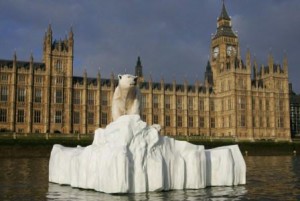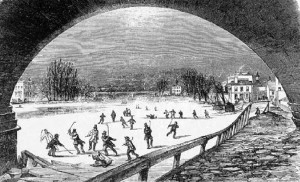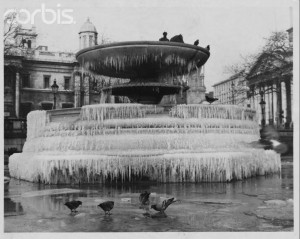Falling Down the Thames Blog 41, 24th December 2014
Take Your Elephant for a Walk this Christmas
Growing up on the Canadian prairies, I developed a keen sense of Winter weather. No one knows Winter better than a child who has to walk to school through drifted snow and howling winds. For instance I knew that any snow that fell before October 31 would shortly melt. However, any snow that fell on or after Halloween would still be around five months later when Spring finally arrived.
Decades have passed, and my memories of frostbite and wind-chill have faded. What remains is rather more romantic, and looks like something from a Currier and Ives Christmas card, complete with ice skaters and horse-drawn carriages.
I suppose that I would have had a completely different perspective on the winter months if I had grown up in my ancestral land of southern England. Thanks to ocean currents bringing warmth north from the equator, Great Britain never gets very cold, right?
Well, not for the past two centuries, maybe, but there was a time when Winter meant Winter! in the UK. According to Tom de Castella of the BBC, the River Thames froze at least twenty-three times between 1309 and 1814. One five occasions, the last in 1814, the ice that formed on the Thames was thick enough for Londoners to turn the situation into an impromptu celebration. People engaged in bowling matches, dancing, football games, horse races, puppet shows and the roasting of oxen were spurred on by the establishment of temporary pubs serving rum and gin. Reporting for Historic UK, Ben Johnson reported that the River Thames sometimes froze for as long as two months at a stretch. There were even reports of an elephant crossing the Thames near Brackfriars Bridge. He was, presumably, part of a circus troupe, and not a startled visitor from India.
The Thames is unlikely to freeze again in my lifetime. Part of this is the result of global climate change, but part is down to local geography. Old London Bridge had many more arches than its successor built in 1831. The newer bridge allowed a faster flow of water upriver on the flood tide. Construction of the river embankment later in the century also made the narrower river flow faster. These changes allowed the tidal Thames to carry salty seawater further upstream, which depresses the freezing point of water. The frost fairs of old are gone.
On behalf of the parade of elves who are helping to put Falling Down the Thames together, I would like to wish you a warm, safe and very Happy Christmas, even if you don’t get to walk your elephant across a river.
- Glen
Photo credits: Polar bear on the Thames – taylorherring.com; winter games on the frozen Thames in 1885 – thames.me.co; frozen fountain in Trafalgar Square, 1963 – britmovie.co.uk



